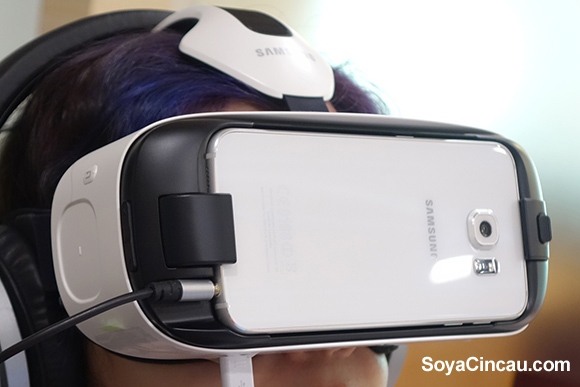Virtual reality is something that most would associate with a sci-fi flick than something you would see in everyday life. But with public interest in VR steadily on the rise we find ourselves with more and more options to escape reality. The Samsung Gear VR is one of those devices, produced in cooperation with the folks behind the Oculus Rift to bring a virtual reality experience like no other, or does it?
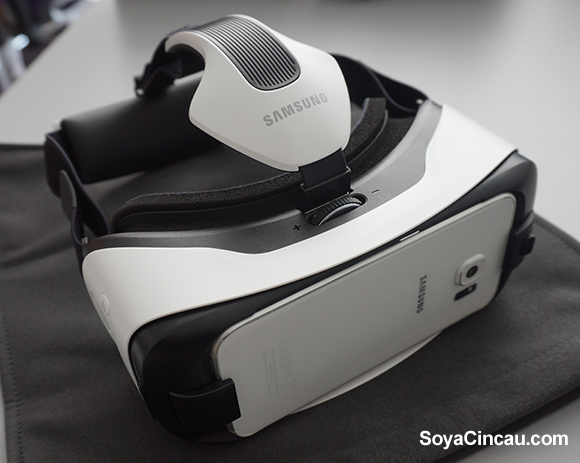
Not to say it is the only VR experience out in the market, with HTC and Valve working together on the HTC Vive headset and Sony having their own VR project called Project Morpheus, on top of Google Cardboard, whose simple nature has already allowed for widespread use of the device.
In a nutshell, the Samsung Gear VR Innovator Edition is basically a pair of VR goggles that operates off your Samsung Galaxy S6 or S6 edge. To put it very bluntly, you could say it is a glorified Google Cardboard made of plastic with adjustable straps and lenses so it fits well on you head. The device mainly leverages off the Oculus’s own tech so the experience is actually quite similar to that of the Rift, if you’ve ever used it before.
There is also another version of the Gear VR which accommodates the Samsung Galaxy Note 4, but it generally operates the same way and is similarly priced, albeit a bit larger to fit the bigger screen.
[nextpage title=”Design and Navigation”]
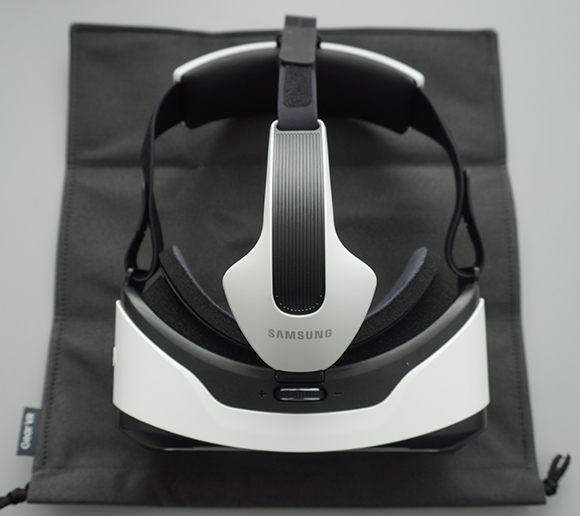
Aside from the main body of the Gear VR, you also get two straps, all of which are adjustable so it will sit properly on your head. As far as we’ve tested it, it fits rather comfortably on most people despite being rather large, thanks to the foam cushioning and straps. Our only gaff with the straps is the uppermost one which hooks onto the main unit tends to sometimes come off when you remove the Gear VR from your noggin, but it’s not something that happens too often.
Out of the box you also get a soft carrying pouch as well as a front plate to snap in when not in use, on top of one piece of replacement face foam as well as a lens cleaning cloth to keep your lenses nice and clean. The face foam adheres to the Gear VR with velcro so its easy to remove and replace, but we don’t see it lasting very long because its made of extremely soft polyurethane foam; the kind that tends to become misshapen after long term use.

The front of the device is where the magic happens. Here is a set of two lenses and the clamp which you mount your phone onto the Gear VR with a touchpad and back button off to the right of the device. The lenses are somewhat adjustable so you can adjust focus of the lenses depending on your needs, which is great because everyone has a different sense of depth so this helps a lot, especially since you cannot wear your glasses while using it.
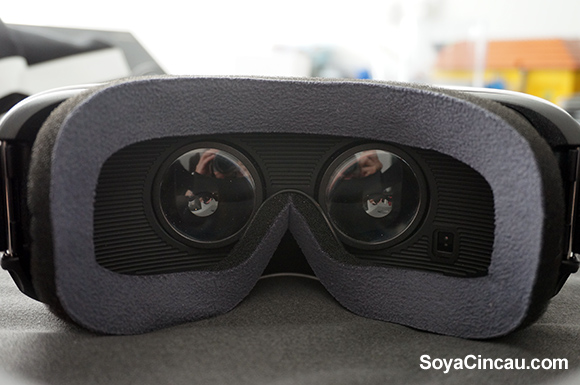
The touchpad is pretty much the only way you can scroll and click OK when navigating the interface. The inclusion of a back button is very welcome as well, letting you exit from apps and return to the Oculus Home menu is quite easy. There is also a volume button just in front of the touchpad so you can jack up the audio without having to manually do it on your headset. While the Gear VR doesn’t have any speakers of its own, it makes use of the phone’s own speakers to handle all the sound. You may or may not like this because it may not be as immersive as smacking on your own headset but it still works in the pinch.
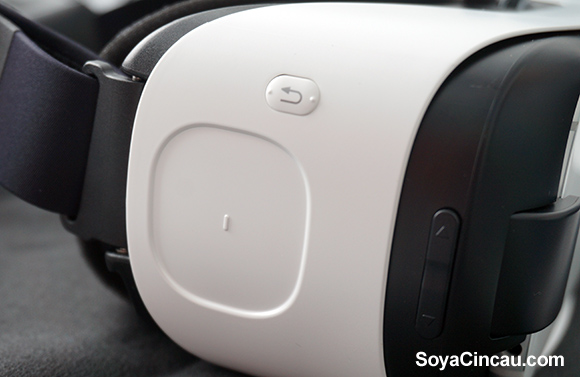
The Oculus Home menu is where you can view your battery life, reorient the headset and even use the passthrough mode to see through the headset using your phone’s camera. That way you don’t have to remove it if say, you need to go pick up a drink from the fridge while you’re watching something. This is not to be confused with the Gear VR’s landing screen, which is where you interact with all the VR content.
The underside of the device is home to a microUSB port in which you can connect a charging cable to the device, which in turn charges your phone. The Gear VR itself runs purely off the power of your Galaxy S6 or S6 edge, so it houses no internal battery.
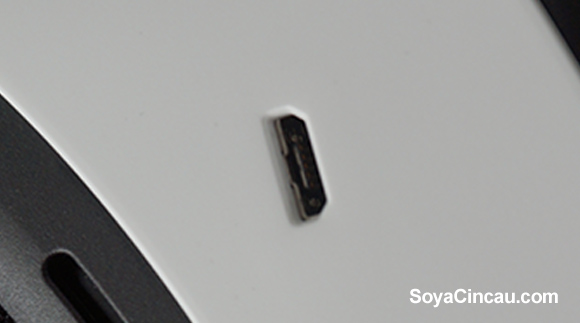
Your phone connects to the Gear VR via a microUSB port and a pair of plastic clamps at the front of the device, securely anchoring it in place. For those who don’t want to rely on the phone’s speakers, they have thoughtfully left a gap where the audio jack is so you can put your own set of headphones in, like what we did. The headset more or less works by tracking using the phone, so you pretty much can’t use it while lying down.
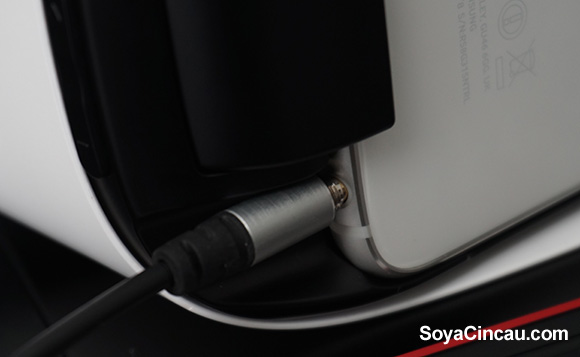
[nextpage title=”Performance & Usability”]
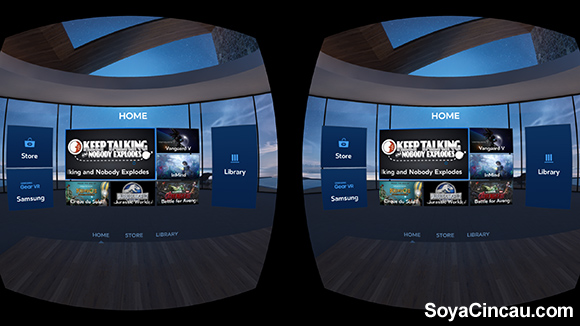
In terms of performance, it’s one of the better VR experiences we’ve tested. Considering I have problems with 3D movies and having tried the original Oculus Rift, both experiences were fairly nauseating. But not with the Gear VR.
Granted you will still feel a bit of vertigo while your eyes re-adjust to your surroundings (especially after playing for quite a long time) but this goes away quite quickly. It probably has got to do with the ability to focus the lenses but as everyone’s eyes are different your mileage may vary. Its also worth noting that you cannot wear your glasses while using the Gear VR, but you generally can’t wear glasses with the vast majority of VR headsets anyway.
Needless to say, the tracking for the Gear VR was very true to movement as in its quite smooth and it feels pretty natural. The Gear VR is still a tad bit heavy and chunky but you do get used to it being clamped on your face. Navigation is pretty simple as well, as you can maneuver around the apps and library with just a few flicks.
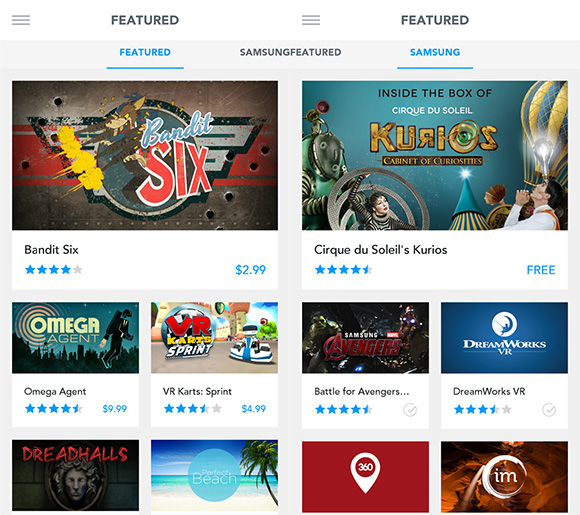
The Gear VR already has quite a few apps made for it, with the vast majority of them being VR experiences with a handful of games thrown in as well. From what we’ve seen so far, a lot of the material is free to download, some crafted explicitly for Samsung like the Divergence movie promo that really makes you feel like you’re tied to a chair in an uncomfortably high place. The price of the apps range from free to about 9.99 US dollars, but the majority of content is free at the moment, even if some are demos.
Some of the games do require Samsung’s mobile controller but most of them only require your head movements to play. You can run the Gear VR’s library when the phone is not attached to the device but it will only allow you to download and otherwise manage your collection.
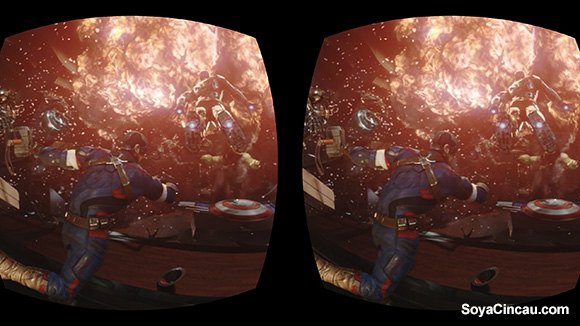
You will also find more familiar apps like Temple Run and the rather well-known VR horror game DreadHalls. It is quite fun to just strap in and enjoy a quick sojourn through space or a quick dive under the sea. Of course, you can watch some videos in one of the movie apps but there’s sadly no YouTube support. This is the same for when you are viewing pictures on your phone. At best the video apps just plonk you into a virtual room as opposed to letting you watch the video in actual VR, and this is with YouTube already supporting 360 video it’s a bit of a letdown.
[nextpage title=”Pricing & Conclusion”]
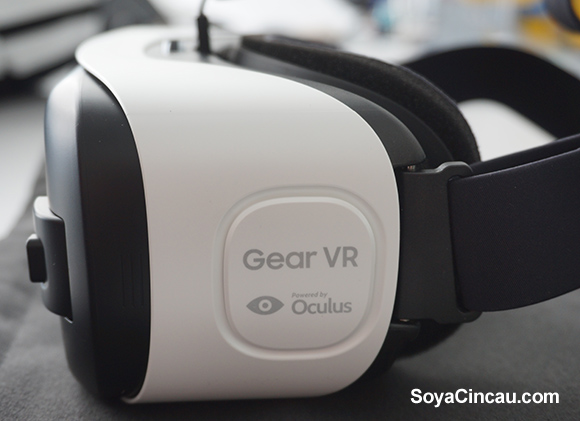
For all its worth, its nowhere near perfect.
One of the biggest issues we had with the Gear VR is that it has a tendency to overheat after about half an hour of use. The phone tends to heat up quite a lot when it’s running and will cease VR operation till it cools down. Same goes for the headset, if it gets too hot it will throw a warning on screen and stop till it gets cool enough.
The unit apparently has a small built in fan in it, but it’s purpose is not to keep the device cool but instead works as an anti-fogging mechanism to ensure your vision doesn’t suddenly go blur. But we find that if you are in a cold enough environment (i.e: in an air-conditioned room set to 16 celcius) the lenses still have a tendency to fog up slightly irrespective of what you do. Thankfully that little fan doesn’t produce any noise that we could hear so it shouldn’t interfere with your immersion.
Cables can also be an issue, if you happen to want to charge your phone while you play AND have a headset strapped on, the ensuing wire tangle can be quite annoying. Especially if your charging cable is pretty short and you end up being bound to your table. Speaking of cables, the device kept asking for us to plug in an original Samsung charger when we were charging it despite using the exact same thing it was asking for.
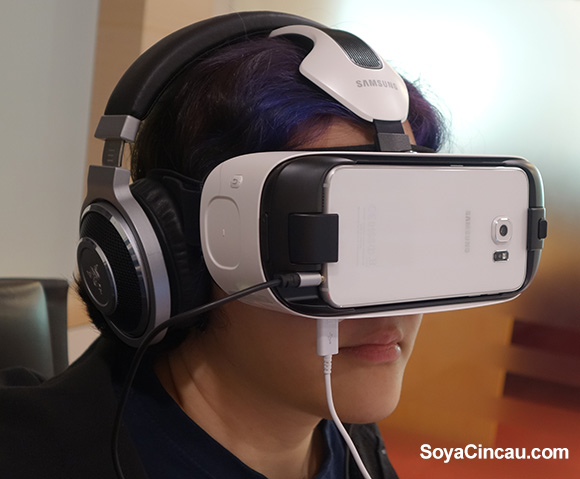
Also, when you are connected to the net while using the Gear VR (which is very likely) and if your phone decides to update, it will toss up a pop-up in the middle of your screen and there’s nothing you can do to get rid of it till it goes away on its own. The Do Not Disturb mode mitigates the problem only slightly, as you will still get Google+ and chat notifications whether you like it or not.
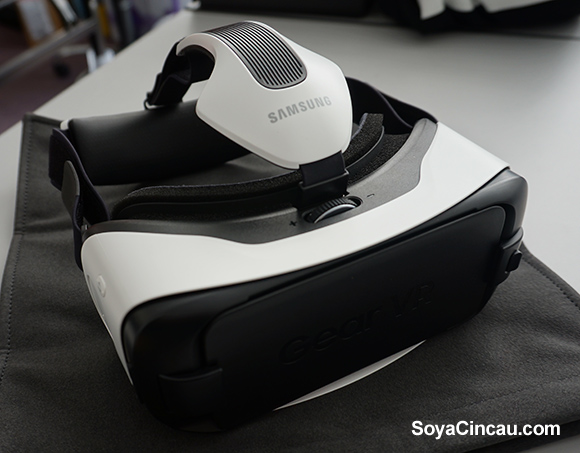
It’s a good first try for Samsung but at the end of the day RM 799 for what basically acts as an accessory to a Galaxy S6 is a bit too much of a price to pay, even if it’s a VR headset. Perhaps if Samsung had made it a bundle with their controller, the price would be more justified we feel it simply isn’t much bang for buck.
However it is worth considering if you really wanted a fancy toy for your equally fancy Galaxy S6 or S6 edge, but we personally would either go for a Google Cardboard if you just want to play around with VR on the cheaps or maybe shell out a more for the next-gen Oculus Rift (about RM 1350 with our current exchange rate) once it hits the market. Both set ups do have their own merit, but it boils down to a matter of budget and personal taste.

